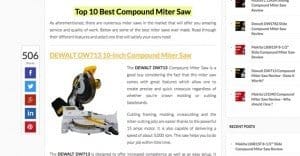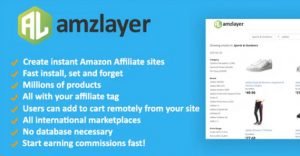How to Increase Your Amazon Affiliate Percentage Easily

Newcomers to affiliate marketing may find that Amazon’s Associates program is the most newbie-friendly and potentially lucrative program out there. It takes seconds to set up and you can generate affiliate links on the fly, set up customized web stores and much more. Amazon even has fairly detailed reporting tools and analytics to help support you in making them – and you – more money. So how can you do both yourself and Amazon a favor, and boost everything from your click-through and conversion rates to your affiliate percentage?
Pick the Right Niche
In some cases, you’ve already settled on a niche and you’re trying to monetize an existing blog. Unfortunately, this is going to be significantly harder than starting a new site specifically to monetize a certain niche. It’s not impossible – in fact, you gain a nice boost from an existing audience – but you’ll find that your product choice may be more narrow than you want.
Some of the best Amazon affiliate sites focus entirely on physical products. More importantly, it’s difficult to get a primarily digital, information-focused blog to successfully sell physical products. It’s all about knowing your niche and your audience; if you’re selling information, don’t try to sell coasters too.
Use Basic Text Links
Amazon has a very pretty little setup for their affiliate links, generating dynamic boxes that pull produce price information directly from their site. The problem is, everyone and their mother knows those are affiliate store links and many people will choose instead to visit Amazon on their own terms to pick up their pet calendars or valentines cards or whatever it is they want to buy.
Text links, on the other hand, are much easier to integrate into a blog post, and they don’t stand out as affiliate links. You obviously need affiliate disclosure on the page, but you don’t need a big honking siren next to the link to drive people away.
Link Product Images
This one is a no-brainer, and if you’re not already doing it, you’re missing out. Whenever you post a picture of the product you’re trying to sell, make that picture a link to the product page with your affiliate code. All too often, I see sites that link the picture to the URL of the picture itself, which does nothing for the user. They aren’t on your site to download product images, they’re there to shop.
Link Often, but Not Too Often
It’s a good idea to include multiple Amazon affiliate links to products throughout a piece, particularly if you’re writing a comparison piece or a usage guide for a particular product. This gives you multiple chances for a user to click through to the product itself, rather than deciding they don’t want to go through the trouble of finding the link and just search it out themselves.
In general, shoot for 1-2 links per “page” of content; that is, per visible section of content. As the user scrolls down, they should always be able to see a link to the product, in some form or another.
Just be careful when you’re posting what might look like thin content. Some popular affiliate sites create robust, data-filled tables for comparing 10+ products all at once, but then link to the product page with their affiliate in the title, product image and a “buy now” link; cramming 30+ links in a relatively small space. This can and will earn you a Google penalty, which can be devastating for your earnings.
Monitor and Review Products
As you’re starting out, you’re going to want to use a scattershot approach to linking to various products in your niche. Write general overviews and product pages for each of these, and monitor which ones perform the best. Which ones receive the most traffic, and which draw in the most conversions?
Once you have a list of the top performing products, you can focus on them with more content. Write detailed product reviews, write usage guides, write homebrew modification tutorials, write anything you can to fill the niche with your content. Every post is an opportunity for a user to come in and see what you have to say, which may convince them to buy.
Build a Mailing List
You don’t need to send out a daily newsletter or anything, but you can build a list of subscribers who are interested in your products. Here’s a general process:
- Compile information into an ebook buyers guide.
- Deliver that buyer’s guide free to anyone who opts in to your mailing list.
- Use that mailing list to deliver a monthly digest of new information and products you feature.
- Use the mailing list to occasionally send out special offers and deals, when you notice price fluctuations.
- Promote products more heavily during holidays, particularly when holiday sales make your products most attractive.
Sell More
Amazon operates on a performance-based price scale that resets every month. During the month, the more you sell, the higher a percentage you get of every sale. Sell more, earn more; it’s a simple formula.
Of course, it’s not that simple to just start selling more. You need to put these other tips into practice in order to increase your traffic and sales, and that will snowball into more earnings for every sale, drastically boosting your income.
One trick you can use is to heavily feature some small, cheap items. These items will be particularly easy to sell due to their inexpensive nature, but they still count for your percentage. Sell a bunch of small, cheap items in preparation for later big sales, to boost the earnings on those big sales.
Send Referrals
Fun fact: you earn a commission on anything a user buys on Amazon after they click your link, regardless of whether you linked to that product or not. If I click your affiliate link that leads to a lawnmower, and I browse around and decide I’m going to order a bunch of Legos instead, you’ll earn a commission for those toys.

 ContentPowered.com
ContentPowered.com






Jarvis Seamster
says:Exactly what I was looking for! I hope this works 🙂
Jamie
says:Hey Kenny, Fantastic advice for all Amazon affiliates. Most people don’t want to focus on making the most of the traffic they have. They just want to pump out content and build links. You could not believe how many websites have bad Amazon links. Out of stock items, moved items, unavailable items, items that now have poor reviews. The list goes on and on. We actually find that most websites have between 5%-15% of their links bringing down their conversion rates and the bigger your site gets the harder it is to keep track of! Such a simple thing to fix but people just let these links rot! It’s madness I tell you. Madness.